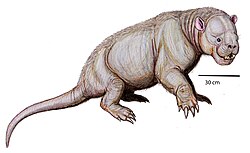| Stylinodon Temporal range: early to middle Eocene | |
|---|---|
 | |
| life restoration of Stylinodon mirus | |
 | |
| skull of Stylinodon mirus | |
| Scientific classification | |
| Kingdom: | Animalia |
| Phylum: | Chordata |
| Class: | Mammalia |
| Order: | † Taeniodonta |
| Family: | † Stylinodontidae |
| Subfamily: | † Stylinodontinae |
| Tribe: | † Stylinodontini Marsh, 1875 [1] |
| Genus: | † Stylinodon Marsh, 1874 [2] |
| Type species | |
| †Stylinodon mirus Marsh, 1874 | |
| Synonyms [3] | |
Stylinodon ("tooth with pilar-like fibers") [7] is an extinct genus of taeniodonts from extinct tribe Stylinodontini within subfamily Stylinodontinae and family Stylinodontidae, that lived in North America from early to middle Eocene. [8] [9] [10] [11]
Contents
With a weight between 54.9 kg (121 lb) and 109 kg (240 lb), [8] and length of 1.30 m (4 ft 3 in), [8] it had similar size to a pig. The skull suggests it had a blunt face, and a very short snout. Its canines had developed into huge, incisor-like root-less teeth. Stylinodon's molars were covered in enamel and continued growing throughout its life. Most likely, it fed on rough roots and tubers. [12]



